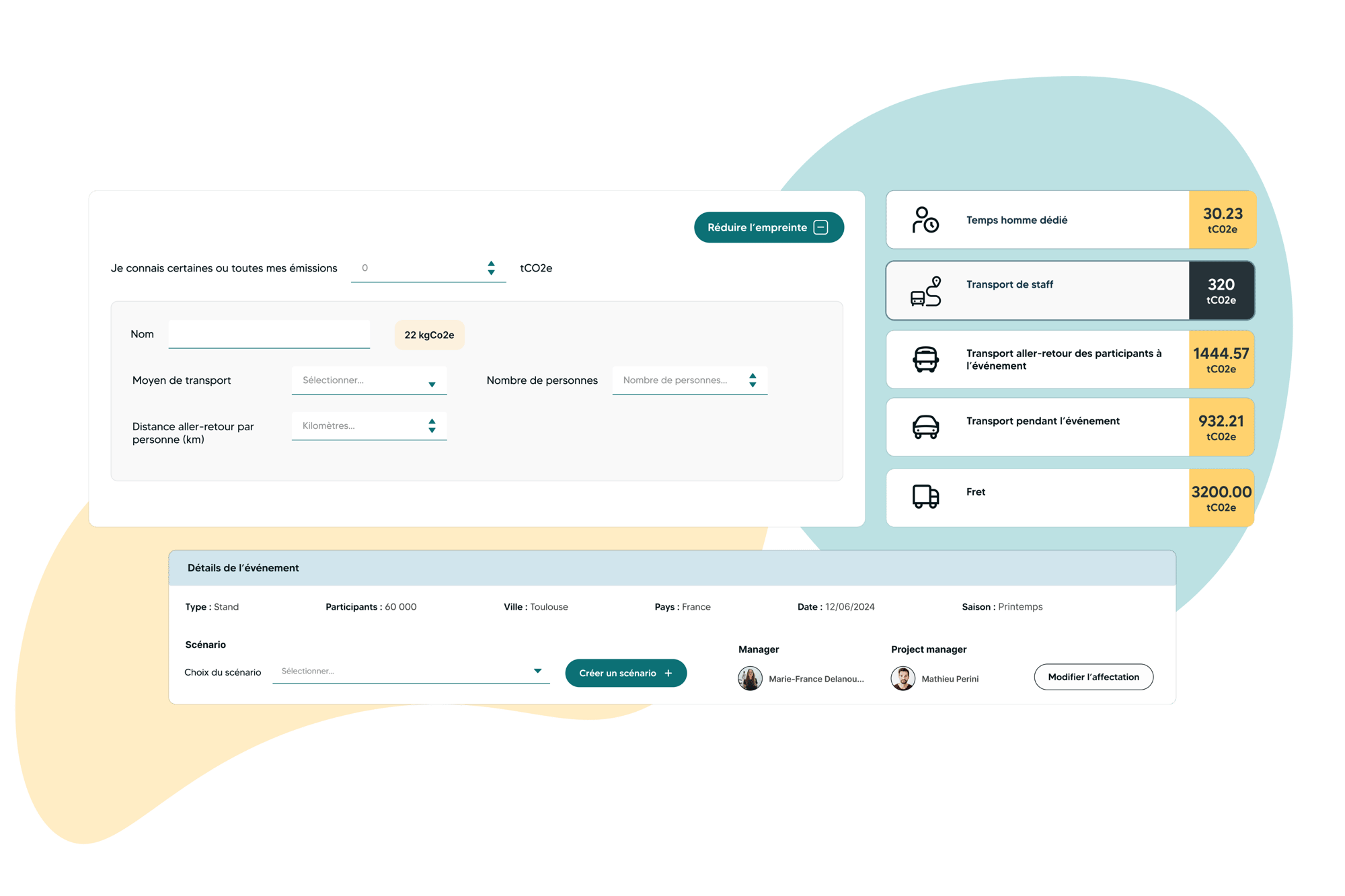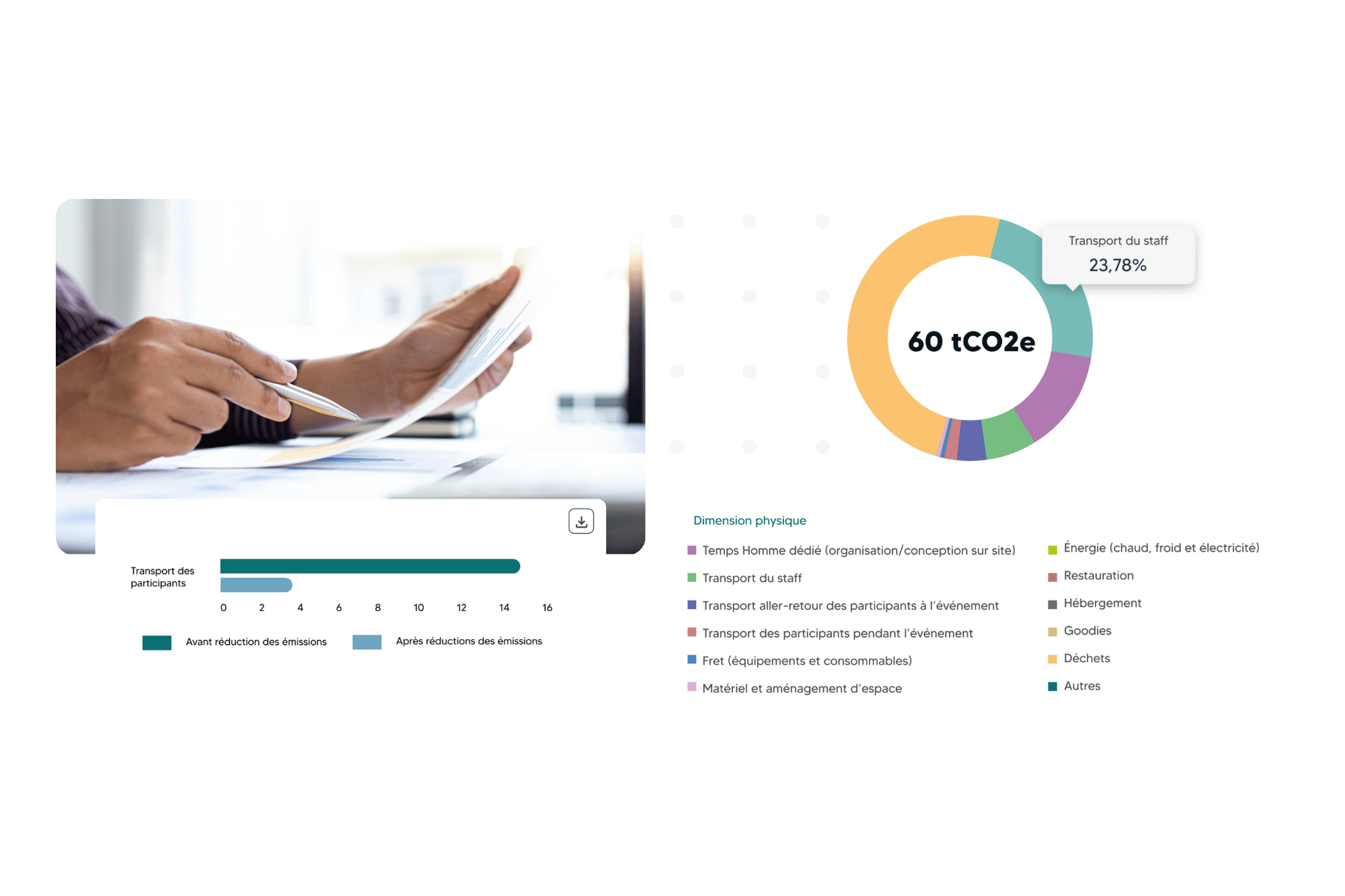Climeet use cases
The solution created by and for event professionals
Measure
The carbon footprint of your events reliably and simply
Reduce
The greenhouse gas emissions of the most emitting flows.
Contribute
To global carbon neutrality by offsetting your residual emissions.

E-learning
E-learning is an essential step in your journey within Climeet, facilitating your access and use of the calculator while enhancing your skills. It consists of 3 modules:
- Understanding climate issues;
- Fundamental principles related to event decarbonization;
- Best practices for using the calculator.
E-learning is mandatory. It ensures that you approach the topic with the necessary level of understanding to achieve quality results.
.png?width=2000&name=Dashboard%20(1).png)
Calculator
Step by step, Climeet guides you through measuring the greenhouse gas emissions of your event. Fill out our calculator with your data, and the tool takes care of the rest! The goal? To obtain a reliable result understandable to everyone.
Emission factors, calculation methodology, and E-learning have been co-developed with the Association for Low Carbon Transition (ABC).
- Adherence to international standards for carbon footprint calculations
- Calculation scope based on the PAS 2060 standard
- Emission factors based on databases specific to the events sector
- Part of the international initiative Net Zero Carbon Events

Data collection
Climeet allows you to collect and calculate data before, during, and after the event. This includes all physical and digital aspects (transportation, technical setup, logistics, catering, communication, etc.) that contribute to the carbon footprint of your event.
- Share tailored data collection sheets with your stakeholders.
- Import the obtained data into Climeet with just one click.
- Engage your partners to obtain the most reliable carbon footprint possible.

Carbon footprint reduction scenarios
Throughout the design of your event, Climeet allows you to easily identify the most emitting posts and activities and test different scenarios to reduce them in just a few clicks.
Determine actions that will have a significant impact. What can you improve? How can you optimize your organization, content, logistics? Test the best options to design your low-carbon event!
With Climeet, combine event excellence and sustainability.

Clear and shareable reporting
Once your event is over, Climeet allows you to obtain a detailed carbon footprint report. You can download it in PDF or Excel format. This report enables you to:
- Obtain detailed results of your emissions by category.
- Communicate your results transparently and confidently.
- Share your best practices while avoiding greenwashing.

Continuous improvement
With Climeet, the improvement of your events' carbon footprint is continuous:
- Refine your post-event assessment.
- Compare your results from one event to another.
- Identify your areas of performance and areas for improvement.
- Aggregate your results over a year or more.
- Develop expertise in organizing low-carbon events.

Contribution
With Climeet, in addition to an ambitious reduction strategy, offset your residual emissions to contribute to global carbon neutrality goals.
Finance projects for reducing or sequestering greenhouse gas emissions. You can choose and finance projects that suit you: size, geography, sector, label, price, technique, etc.
An expert can advise and support you every step of the way!
By your side for your project
Climeet is your committed partner in your journey towards sustainability and reducing the carbon footprint of your events. We accompany you with innovative and sustainable solutions to make every gathering a step towards a more environmentally friendly future.
Contact us
Our experts will be delighted to answer all your questions!
Frequently Asked Questions
Here, find the most frequently asked questions by users.
An event gathers a set of scenarios of said event that you can create/modify until the completion of your data collection. As long as the status of your event is 'in progress,' you can create as many scenarios as needed to understand the carbon impact of different options available to you. Subsequently, you simply need to 'finalize your calculation' to access and download your comprehensive results. A finalized event is no longer editable.
It depends on the size of your event, the number of associated data, the dedicated manpower internally, the responsiveness of your service providers to provide their data, etc.
The mandatory information corresponds to the parameters of your event that are requested before creating an event: country, city, season, number of participants, year, considered currency, number of days, type of event. Among these parameters, only the season, currency, and country of the event directly affect the calculation.
The e-learning is mandatory and lasts a few hours. The e-learning training lasts between 2 and 5 hours, depending on your initial level of knowledge. This training is essential to be able to use the Climeet tool.
The different emission categories come from a global mapping of the carbon flows of an event and are categorized according to the operational reality of an event. The mapping of flows is aligned with the Bilan Carbone® method, the PAS 2060 standard, and the GHG Protocol.
We use reliable databases and methods, reviewed by the Association for Low Carbon Transition (ABC). Your event footprints will be consistent and comparable since they will be based on the same methods and scope. The reliability of the results will largely depend on the quality of your activity data. We encourage you not to neglect data collection and to approach as closely as possible to the reality of your event. For periodic events, it is important to note your assumptions to apply the same method.